New releases from the BFI, 2016
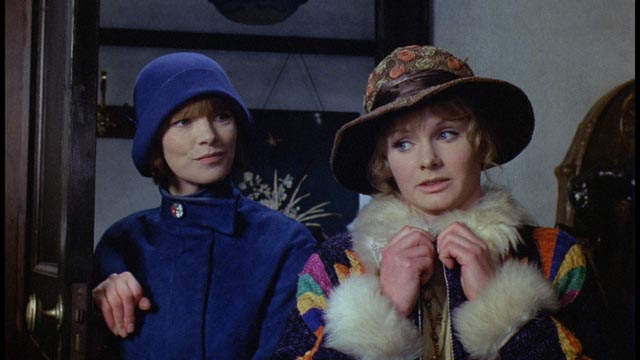
I recently got a new batch of BFI releases from England which reflect some interesting points about the British film industry back in the ’70s. These titles reveal conflicts between art and commerce while trying to reflect various specific aspects of English life and history.
Women in Love (Ken Russell, 1969)
Ken Russell worked steadily on television through the 1960s, beginning with documentary shorts before creating a distinctively personal – and idiosyncratic – mixture of documentary and drama for a series of BBC films about the life and work of composers, artists and writers in which he used a kind of impressionism to illuminate the relationship between creators’ often flawed lives and the art they created. Twice during the decade he ventured into features, in both cases appearing not to be entirely comfortable with the material he was given – a seaside comedy called French Dressing (1964), which suffered from severe cutting by the distributor because it ended up as something other than a coarse Carry On-style comedy; and Billion Dollar Brain (1967), the third Harry Palmer thriller which eschewed the bleak Cold War dramatics of Sidney J. Furie’s The Ipcress File (1965) and Guy Hamilton’s even bleaker Funeral in Berlin (1966), with Russell virtually deconstructing the genre through absurdist, almost slapstick comedy.
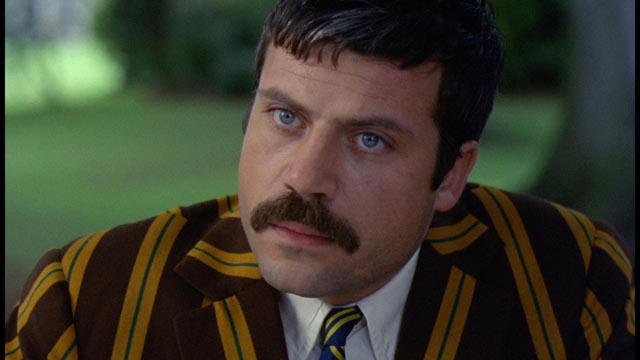
It was at the end of Russell’s tenure at the BBC, just before an acrimonious parting of the ways over Dance of the Seven Veils (1970), his film about Richard Strauss, which was quickly suppressed due to legal action taken by Strauss’s family because the film explicitly links the composer with the Nazis, that Russell made his breakthrough with a third feature which gave full expression to his style and creative interests. Yet he didn’t initiate the project; in fact, writer and co-producer Larry Kramer had been shopping his script around for some time, failing to interest such diverse filmmakers as Peter Brook, Jack Clayton, Stanley Kubrick and Silvio Narizzano before it reached Russell.
Women in Love (1969), adapted from D.H. Lawrence’s novel, offered Russell many things – a period in which freedom wrestled with oppressive social constraints; architecture and fashions which provided opulent visuals to complement the drama; and a narrative which plays out themes of conflict between the animal, specifically sexual, nature of human beings and the powerful but flawed social structures we erect to channel and control our own behaviour. Set just after the First World War, in a society reeling from that vast disruption, the story centres on five characters living in a northern mining town where the lines of class division are etched into the flesh of the people.
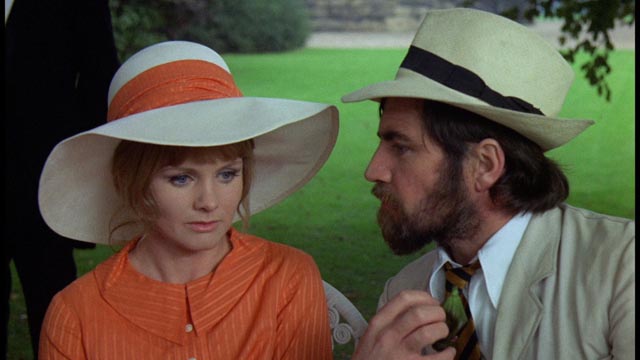
Sisters Gudrun and Ursula Brangwen (Glenda Jackson and Jennie Linden respectively) are already breaking away from their lower middle class background, dressing in a modern style which draws derision from the working people of the town among whom they move. As teachers at the local school, their social prospects are rather limited, but in such a close society they come to the notice of Rupert Birkin (Alan Bates) and Gerald Krich (Oliver Reed), men above their station, but also feeling dislocated in the war’s aftermath. Rupert is angry and rebellious (he causes a scene at a ceremony remembering the war dead by loudly attacking the whole idea of honour in death); Gerald is the son and heir of the local mine owner, given to a hard, even sadistic, streak which denies the old sense of noblesse oblige by which his ageing father has lived and “cared for” his men. Gerald is a modern capitalist; all that matters is efficiency and the bottom line, an attitude which causes him to harshly discard loyal workers when they begin to grow too old to put in the full effort of which they were once capable. The sickness of Gerald’s attitude is highlighted by the madness of his mother, a crazed old matriarch who despises the poor to the point of setting vicious dogs on a party of workers who come to the manor to see her husband.
Gudrun and Ursula are contrasted with Hermione Roddice (Eleanor Bron), a woman born to privilege whose sexuality is channeled into pretentious artistic expression; a performance she puts on at the manor, into which she draws the two sisters as virtual props, affords Russell an opportunity both to display the period’s “modern dance” and simultaneously skewer its distance from raw emotional expression.
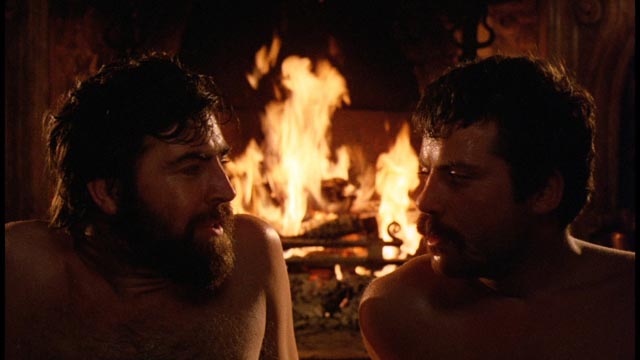
While the title suggests that the film’s (and novel’s) focus is on the two sisters, Gerald and Rupert carry an equal part of the dramatic weight. In fact, the relationship between the two men is as important as their relationships with the two women. Rupert and Gerald seek an emotional and spiritual connection with one another which they conceive as somehow more pure, more lasting than the conventions of romantic love. This desire is given full and startling expression in one of the most famous scenes from the period, one which was surprisingly passed uncut by the censors because the people in charge of the BBFC recognized the film’s artistic seriousness (a pity that this same recognition just two years later did not prevent them from hacking away at Russell’s masterpiece, The Devils [1971]). This is the nude wrestling scene with Rupert and Gerald grappling by firelight in one of the elegant rooms of the manor. Desiring to assert their masculinity in this primal contest, they instead reveal the powerful sexual pull which exists between them.
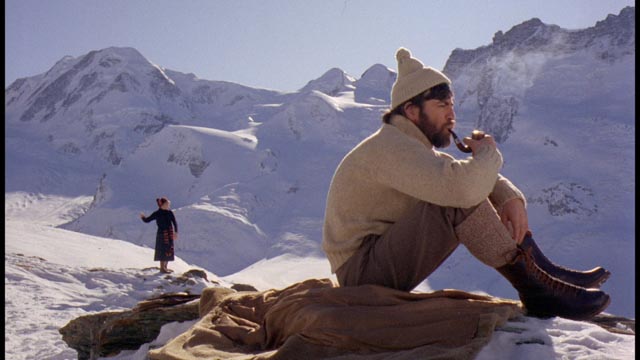
The forbidden nature of these feelings pushes the two men into their relationships with the two sisters; uncertain masculinity finds itself at the mercy of a newly assertive femininity. As feelings ebb and flow and the two couples eventually escape England for the continent and what initially seems like an idyll in the Swiss Alps, far from England’s stifling social constraints, Gudrun mercilessly eviscerates Gerald, flaunting her new-found connection with a dubious continental artist named Loerke (the inimitable Vladek Sheybal), pushing him to the point of almost begging for her affection – and having finally pried the words “I love you” out of him, she coldly discards him.
The film ends surprisingly abruptly with a parallel scene between Ursula and Rupert in which he expresses his desire to hold on to two kinds of love – his connection with Gerald and his connection with her – only to have her declare forcefully that this is impossible.
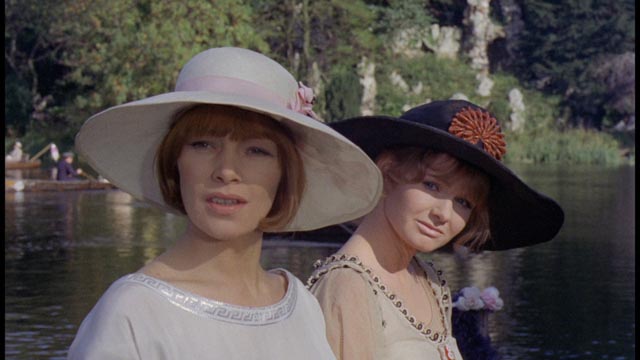
While the film is a richly detailed evocation of its period, with wonderful costume and set designs by Shirley Russell and Luciana Arrighi, it has none of the precious and staid qualities of so many British costume dramas. Stylistically, Russell infuses it with energy from the very first moments, shooting much of it with a restlessly moving, yet precise, handheld camera (cinematographer Billy Williams was nominated for an Oscar for his work, along with Russell as director and Kramer as writer); but he also tapped into the parallels between the social upheavals which followed the First World War and those of the ’60s which had done much to break down rigid ideas of class and sexuality. Even now, almost fifty years after it was released, the film feels completely undated because it was made with a sense of urgency as well as an intense commitment to the craft of filmmaking … qualities which Russell brought just two years later to The Devils, a film which also finds parallels between its historical period and the filmmaker’s present.
As one of the most significant British films of its time, it seems both strange and sadly inevitable that Women in Love should have been made with American money, produced by Americans, and released by an American company. By the end of the ’60s, years after the flourishing of the new wave which produced the early works of Tony Richardson, John Schlesinger, Karel Reisz and others, the national industry was once again in disarray. Even Hammer Films was on its last legs, struggling to retain some sense of relevance while collaborating with Warner Brothers to produce little more than pale echoes of its former glories. Just four years after Russell’s breakthrough, a former Hammer director, Don Sharp (Kiss of the Vampire, The Devil-Ship Pirates, Rasputin: The Mad Monk), made one of the oddest and least-reputable post-Hammer horror films.
*
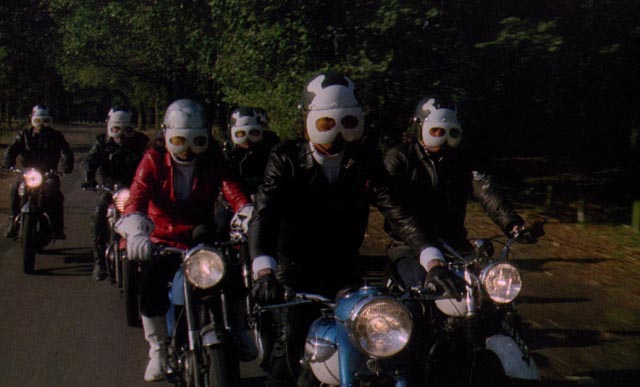
Psychomania (Don Sharp, 1973)
Apparently producer Andrew Donally had a number of projects he was trying to get off the ground, but was having no luck – until he mentioned a story about a biker gang that commits suicide and comes back from the dead to wreak havoc on an English town. He pretty much got the money instantly on a handshake.
There are so many absurdities in Psychomania (1973), written by Julian Halevy and Arnaud d’Usseau (among whose previous work was Eugenio Martin’s Horror Express [1972]), that it’s not surprising that it eventually developed something of a cult despite (or because of?) its many shortcomings. Made on the cheap, it nonetheless has some biggish names in the cast. It stars Nicky Henson, a classically-trained stage actor who has had a long and very prolific television career interspersed with occasional theatrical features (including Michael Winner’s The Jokers, Michael Reeves’ Witchfinder General and Stephen Gaghan’s Syriana); Robert Hardy, another prolific stage, TV and film actor, just a few years away from his defining role in the popular All Creatures Great and Small; and more surprisingly, Beryl Reid, adept at both comedy and drama, whose biggest role was probably as June Buckridge opposite Susannah York’s Alice McNaught in Robert Aldrich’s The Killing of Sister George (1968).
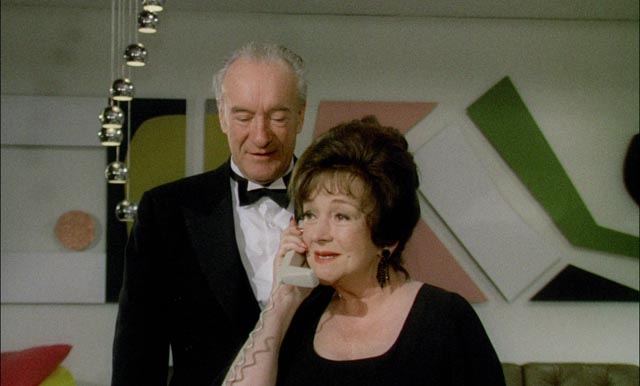
Most surprising, and somewhat sad, is the presence of George Sanders, returning to British horror thirteen years after starring in Wolf Rilla’s chilling Village of the Damned (1960). Sanders died a suicide before Psychomania was released, and legend has it that he took the fatal overdose after having seen a rough cut of the movie. Ever the professional, he manages to conceal any signs of contempt for the material, although Henson says in interviews that the two of them had a hard time not cracking up in front of the camera.
Although Don Sharp had previously proved himself quite adept at the genre of the English Gothic – Kiss of the Vampire is one of the best of Hammer’s minor horrors, while Devil-Ship Pirates is the studio’s finest non-horror period film – Psychomania is tonally discordant; one wants to think that its many absurdities are deliberately intended as straight-faced comedy.
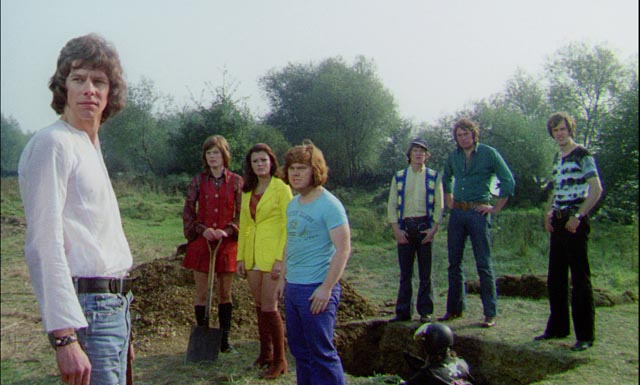
Henson plays Tom Latham, the nihilistic leader of a biker gang who call themselves The Living Dead; they roam the country lanes, running unsuspecting motorists off the road, laughing with pleasure when one unlucky traveller flies through his windshield. He’s also the son of Mrs. Latham (Reid), a medium who seems to have genuine powers which she uses to help bereaved people talk to their dead loved ones. She’s assisted in her work by Shadwell (Sanders), who seems to be much more than a butler. Tom believes that his Mum knows the secret of returning from the “other side”, something she’s reluctant to share with him because of the risks involved; apparently his own father died in the attempt. But when he finally overcomes her resistance, he’s given the key to a locked room where he has some kind of vision which seems to show his mother making a pact with the Devil over his own baby self.
Following this, he’s told that the secret is simply that you must kill yourself without hesitation while being absolutely convinced that you’ll come back. While this seems a bit dubious as a plot device, it does provide Sharp with several opportunities to stage imaginative suicides.
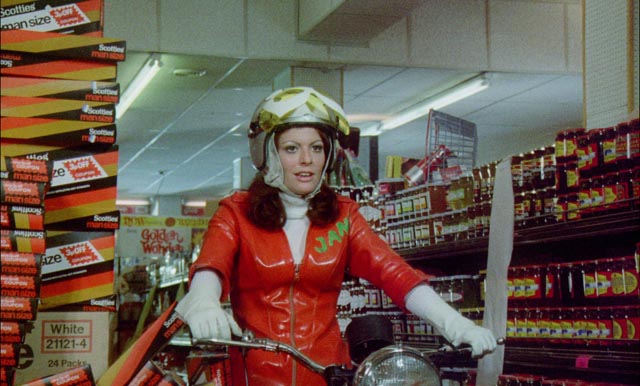
After Tom kills himself by riding at high speed off a bridge over the Thames, the movie reveals its own conceptual confusion by staging a bizarre funeral in which the gang bury his body, sitting upright on his bike, in the middle of a ring of standing stones (which, legend has it, were once seven witches who reneged on their evil pact and were punished by Satan). The really weird thing here is that the gang have all stripped off their leathers and are now dressed in the flowery garb of hippies, weaving wreaths of wild flowers while one of them sits beneath a tree strumming a guitar and singing a folk ballad called “Riding Free” (written and dubbed over the actor by singer-songwriter Harvey Andrews). How the gang is momentarily transformed into these delicate, sensitive spiritual children is never explained and the moment passes after Shadwell shows up to toss an amulet into the grave and Tom’s second-in-command Jane Pettibone (Ann Michelle) steps up to assert her authority as the gang’s new leader.
It’s not long before Tom bursts out of the ground on his roaring bike, slaughters the inhabitants of a country pub, and persuades the rest of the gang that they can be immortal just like him. This leads to the string of suicides and an escalating rampage through those country lanes and suburban shopping precincts. The film’s most shocking moment comes as they destroy a supermarket and Jane runs down a mother and baby in one of the aisles.
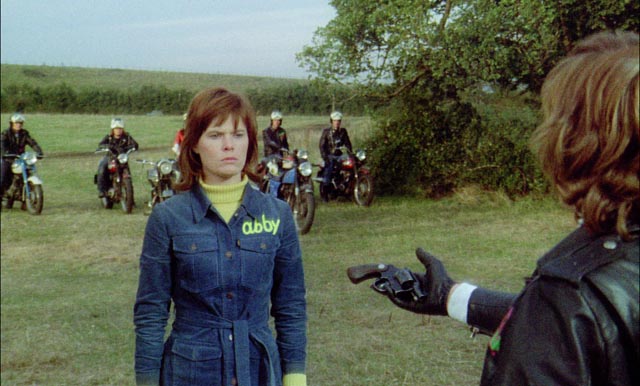
With Tom’s nihilism at full bore, Mum realizes that she has perhaps failed to raise him properly and she decides to end the carnage by rescinding her agreement with the Devil (which for some reason will turn her into a frog for all eternity). She acts without a moment to lose as the gang close in on Tom’s former girlfriend Abby (Mary Larkin), who has decided that she’d rather just live a normal life and not spend eternity as an unfettered agent of evil.
Although there are some occasionally striking images – the title sequence, with the gang riding formation in and around the standing stones in the early morning mist as John Cameron’s prog rock theme plays atmospherically, promises far more than the movie can deliver – the pleasures of Psychomania are those of a film whose cheapness and creative shortcomings produce an almost constant sense of surprise, the what-on-earth-were-they-thinking effect that characterizes so many good-bad movies. Strange that this attempt to marry American genre tropes (the outlaw biker gang) with more typically Gothic English elements should have found English financial backing, while Ken Russell needed American money to make his very English creative breakthrough, Women in Love.
The disks
The BFI Blu-rays of both these films are impressively produced (Psychomania, the latest from Flipside, even gets a dual-format release). The 4K restoration of Women in Love supports the films lush visuals with a genuine film look; the colours are rich and the image has a lot of texture. The extras include two commentary tracks, with Russell and writer-producer Kramer, which were both recorded for an earlier DVD release. There’s a lengthy conversation with cinematographer Billy Williams; an even longer (audio-only) conversation with Glenda Jackson; a brief documentary about Jackson shot while she was filming John Schlesinger’s Sunday, Bloody Sunday, in which we get to see her working on a difficult scene from that film. There’s also an adaptation of a D.H. Lawrence short story, Second Best (1972), produced by Alan Bates, starring him and his then-wife Victoria Ward. Directed by Stephen Dartnell, it strives for an almost mystical atmosphere with long, slow, wordless sequences set in the verdant English countryside as the recently jilted Fran (Ward) works towards a relationship with taciturn farmer Tom (Bates). Dead moles are involved.
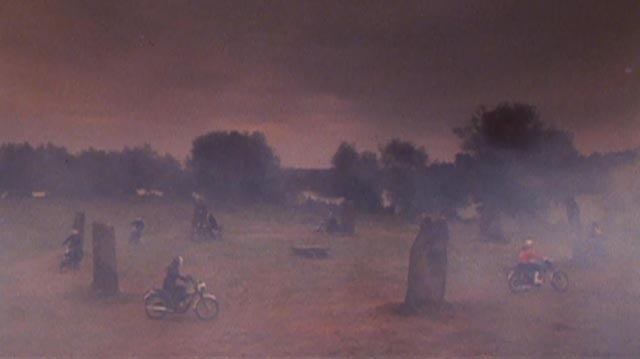
Psychomania could have benefited from a commentary by Kim Newman or Alan Jones, but there are nonetheless some interesting extras (some of them produced by Severin Films for a U.S. release). Nicky Henson provides some engaging anecdotes in an interview, most of which irritatingly are repeated almost word for word in the Severin featurette Return of the Living Dead, in which they are blended with the recollections of others, including Mary Larkin and several of the stuntmen/gang members. There’s a featurette about the score, as well as one dealing with the song “Riding Free”. Another in which the owner of the company which provided the gang’s leathers gives a brief history of a hundred years of biker clothing; a short travelogue about the stone circle at Avebury presented by the poet John Betjeman; and a very brief piece about the film’s restoration from three colour-separation masters. This restoration may have performed miracles, but the film as presented on the disk is still very uneven, with a lot of fluctuations in colour and contrast, though when it looks good, it does look very good. Finally, there’s a strange short produced by a church group called Roger Wonders Why (1965), which depicts the “legendary 59 Club”, founded by a vicar to give kids a sense of purpose which revolves around motorcycles.
*
I’ll write next about two more BFI releases, both dealing with the relationship of people to the land: Peter Hall’s Akenfield (1974) and Andrew Grieve’s adaptation of Bruce Chatwin’s On the Black Hill (1988).
Comments